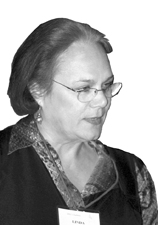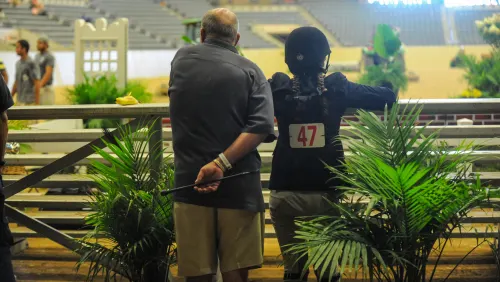 I`ve been lucky (I think?) enough to have been involved in the show jumping team selection process, to one degree or another, since 1986. Back in the late `70s I also spent a little time on the athlete side of things; three or four times for CSIO Spruce Meadows (Alta.) as well as a short stint on the `long list` for 1980`s ill-fated Moscow Games. I even served on a selection panel for a Mexican team a few years back.
I`ve been lucky (I think?) enough to have been involved in the show jumping team selection process, to one degree or another, since 1986. Back in the late `70s I also spent a little time on the athlete side of things; three or four times for CSIO Spruce Meadows (Alta.) as well as a short stint on the `long list` for 1980`s ill-fated Moscow Games. I even served on a selection panel for a Mexican team a few years back.
Thus I feel I`ve achieved a fairly good perspective on the history and evolution of team selection during the last 25 years.
Every single year the goal has been the same: to achieve a successful result while using a fair selection process. Have we achieved both aspects of this goal every time a team has been selected for a major event? Perhaps not, but it doesn`t mean we haven`t always been trying.
During the era of Bert de Nemethy, selection wasn`t a matter for committees and such. Bert trained the riders and horses that met his stringent requirements–from all over the country–at the U.S. Equestrian Team headquarters in Gladstone, N.J., and then chose teams for European tours and championships. And they usually won medals.
Were his choices always without controversy? Of course not. But back then fewer riders felt prepared to compete internationally.
The biggest difference be-tween the de Nemethy era and today is numbers. We now have far more candidates competing weekly, and many more dollars are being spent to achieve a place on a team. This can`t help but lead to plenty of disappointment when only four riders constitute a team for any championship.
After Bert`s retirement in 1980, the responsibility for team selection moved to a selection committee. In my naivet I accepted the honor of chairing this committee in 1986. Filled with a group of knowledgeable and honorable horsemen, the committee utilized a series of observation trials, together with past experience of horse and rider, to name the team for the 1986 World Championships.
The candidates ranged from Olympic individual silver medalist Conrad Homfeld, to a young Katharine Burdsall making her very first European appearance.
ADVERTISEMENT
It was a gratifying experience to watch our team win the gold medal that year, especially the crucial rounds Katharine produced! That gold, plus Con-rad`s individual silver, seemed to be an auspicious start for our new era of team selection.
But in 1988 some unforeseen problems appeared with the selection system. With competitors free to choose which of the trials to contest, we ended up with two riders (Peter Leone and Katharine Burdsall) essentially “equally qualified” for that all-important fourth spot on the Olympic team. Our committee was faced with the unenviable task of making a decision between two team veterans, and we chose Katharine.
We were well aware that either choice would leave one very disappointed individual off the team, and that tough decision resulted in formal arbitration proceedings. Fortun-ately, the arbitrator reached the same conclusion as we did: The riders were as nearly equal as the process could determine; the committee`s actions were vindicated.
Learning some of the flaws in the process with each passing year, by the time selections for the 1990 World Equestrian Games came around, we were requiring head-to-head competition. Selected riders would then go to Europe to determine the final four.
Once again the first three riders were obvious. The last spot was the real conundrum. A former Olympic horse/rider combination (Anne Kursinski on Starman) had had good, if slightly erratic, results through the trials and in Europe. The other rider (Debbie Dolan on VIP) had substantially less international experience but was better in the U.S. trials. We selectors debated long and hard, only to have our decision in favor of Debbie re-versed by the USET`s Executive Committee.
This time the U.S. Olympic Committee`s arbitration rules didn`t apply, and Debbie filed a lawsuit. Again, the USET and the federation eventually prevailed, but we were not to see selections based on anything but a purely objective process for 12 years.
Using total objectivity in 1992, we lost Gem Twist, the silver medalist at the 1988 Olympics and “best horse” at the 1990 WEG, from our Barcelona Olympic team as the result of his aversion to a single jump in a trial under lights. While Norman Dello Joio expertly piloted a relatively inexperienced Irish to an individual bronze, we failed to medal in the team event.
Learning from the Gem Twist fiasco a “drop score” was introduced to the selection process for 1994. But our results at the WEG had our team in fifth place and our best individual (Patty Stovel) claiming 13th place. It was a major disappointment.
ADVERTISEMENT
We were learning that the very subjective process of designing an objective system of selection just wasn`t as easy as we thought.
For the 1996 Olympics on our “home turf” in Atlanta, our system worked a bit better. Our riders and horses dug deep to emerge with a deserved silver medal, but no one could place individually.
The 2000 trials were rela-tively uneventful–albeit pressure-packed–but the futility of trying to reduce veterinary issues into “black and white” caused problems afterward. While some relatively inexperienced horses and riders put in good rounds, we came home empty handed once again. Everyone was feeling that a more major change in our system might be warranted.
For the first time in 12 years a degree of subjectivity was approved as part of the selection procedure for the 2002 WEG. A selection committee, made up of recommendations from the riders themselves, got the option of naming one horse/rider combination on a subjective basis.
The selectors chose not to exercise their option, though, and our team result (sixth) was more than disappointing, despite Peter Wylde`s individual silver medal and the “best horse” title for the wonderful mare Fein Cera. Just as in 1998, we`d need the Pan Am Games to qualify for the Olympics.
The ice broken on subjectivity, a maximum of two subjective choices were permitted last year. One was used in advance of the trials for Chris Kappler and Royal Kaliber; the other went to injured but healing Lauren Hough. And our country`s first gold medal in far too long felt awfully good–it also assured that two selective choices would be a part of this year`s process.
And this year`s trials are having plenty of drama. Chris and Royal Kaliber were selected prior to the trials. Margie Engle, who fractured her femur in February, was denied a waiver and rode Hidden Creek`s Perin to a clear in the first round before feeling unable to continue. And the committee has decided to stick with the results of the trials for the other three riders.
It`s impossible to predict results in advance with consistency, and it`s almost as difficult to predict exactly how well a selection procedure will deal with the ever-changing circumstances encountered in a given year. We can only be sure that there will be more than a few very disappointed people after any U.S. team selections are completed.
For the riders or owners who won`t make the team this year (or two years from now), and for the fans with a particular favorite who didn`t qualify, keep in mind that the only way for every single deserving rider to represent his or her country when a big event comes along is to live in a country with only four deserving riders. We`re lucky to have many more than four–and consequently unlucky in that we must have some means of selecting who will wear the flag and who will not.
We must remember what matters far more than the trials: the championships themselves. It`s time we field a team that can show the world the style, class, and results produced by our all-time “Dream Team” at the 1984 Los Angeles Olympic Games. I think we can do it.














